List of Australian flags
From Wikipedia, the free encyclopedia
This is a list of flags of different designs that have been used in Australia.
Wikimedia Commons has media related to Flags of Australia.
National flags
| Flag | Date | Use | Description |
|---|---|---|---|
 |
1901–1903 | Original 1901 Federal Flag Design Competition winner[1] | A Blue Ensign defaced with the six-point Commonwealth Star in the lower hoist quarter and the five stars of the Southern Cross in the fly half (each star had a varying number of points: 9, 8, 7, 6 and 5—with Alpha Crucis being larger than Beta and Gamma and with Delta being smaller than Beta and Gamma[2]). It was first flown in Melbourne on 3 September 1901, that date now recognised as Flag Day. |
 |
1903–1908 | Flag as approved by King Edward VII[1] | Flag modified so that all stars of southern cross have seven points, except the smallest star with 5 points |
 |
1908–present | Australian National Flag, naval jack and state ensign[1] | Flag modified with the addition of one point to the Commonwealth Star |
State and territory flags
| Flag | Date | Use | Description |
|---|---|---|---|
 |
1876–present | Flag of New South Wales[3][4] | A St George's Cross with four gold stars and a lion in the fly of a British blue ensign. |
 |
1877–present | Flag of Victoria[3] | The Southern Cross surmounted by a crown in the fly of a British blue ensign. |
 |
1876–present[a] | Flag of Queensland[3] | A light blue Maltese cross with a crown on a white background in the fly of a British blue ensign. |
 |
1904–present | Flag of South Australia[3][5] | A piping shrike on a gold background in the fly of a British blue ensign. |
 |
1953–present | Flag of Western Australia[3] | A black swan on a gold background in the fly of a British blue ensign. |
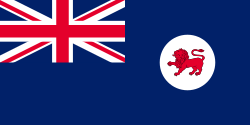 |
1876–present | Flag of Tasmania[3] | A red lion on a white background in the fly of a British blue ensign. |
 |
1993–present | Flag of the Australian Capital Territory[3] | One third blue with the Southern Cross, the other two thirds are yellow with the coat of arms of Canberra. |
 |
1978–present | Flag of the Northern Territory[3] | One third black with the Southern Cross, the other two thirds are Ochre with Sturt's Desert Rose, the floral emblem of the Territory. |
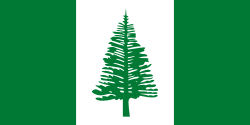 |
1980–present | Flag of Norfolk Island[3] | A green field with a white square containing a green Norfolk Island pine. |
Unofficial territory flags
| Flag | Date | Use | Description |
|---|---|---|---|
 |
1986–present | Flag of Christmas Island[3] | The blue and green diagonal panels represent the sea and the island's vegetation, a small map of the island is included in the centre. The main emblem is a golden bosun bird. The flag was selected from a competition held in 1986. |
 |
Flag of the Cocos (Keeling) Islands[3] | The flag is green, with a palm tree on a gold disc in the canton, a gold crescent for the Cocos Malay people in the centre of the flag and a gold southern cross in the fly. |
Historic state flags
| Flag | Date | Use | Description |
|---|---|---|---|
 |
1870-1877 | Flag of Victoria[6] | |
 |
1877 | Flag of Victoria[7][6] | |
 |
1876–1963 | Flag of Queensland[8] | |
 |
1870–1876 | Flag of South Australia[9] | |
 |
1876–1904 | Flag of South Australia[9] | |
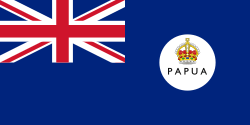 |
1902–1949 | Flag of the Territory of Papua[citation needed] | British blue ensign with a white disk on the fly, filled with the Tudor Crown and the word "PAPUA". |
 |
1914–1949 | Flag of the Territory of New Guinea[10] | British blue ensign with a white disk on the fly, filled with the Tudor Crown and the initialism "T.N.G." |
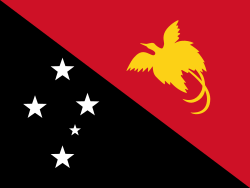 |
1971–1975 | Flag of the Territory of Papua and New Guinea[10] | The upper triangle is red with the soaring Raggiana Bird of Paradise and the lower triangle is black with the Southern Cross of four white larger five-pointed stars and the smaller star. |
Nationally proclaimed flags of Indigenous peoples
| Flag | Date | Use | Description |
|---|---|---|---|
 |
1971–present | Australian Aboriginal Flag[11][12] | A black and red flag with a yellow circle in the middle. The flag was designed in 1971 by Harold Thomas. |
 |
1992–present | Torres Strait Islander Flag[11][12] | A five-pointed star and traditional headdress in white, on a blue, green and black background. It was designed in 1992 by Bernard Namok. |
Royal and viceregal flags
Sovereign
| Flag | Date | Use | Description |
|---|---|---|---|
 |
1962–2022 | Personal Australian Flag of Queen Elizabeth II[13] | Consists of a banner of the coat of arms of Australia, defaced with a gold seven-pointed federation star with a blue disc containing the letter E below a crown, surrounded by a garland of golden roses. |
 |
2024–present | King's Flag for Australia[14][15] | Consists of a banner of the coat of arms of Australia. |
Governor-General
| Flag | Date | Use | Description |
|---|---|---|---|
 |
1909–1936 | Flag of the governor-general of Australia[13] | A Union Flag defaced with a seven pointed star, crowned, surrounded by ears of corn and a gold circlet. The crown used is the Tudor Crown. |
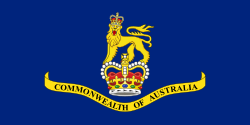 |
1936–1963, 2024-Present | Flag of the governor-general of Australia[16] | A crowned lion standing on a crown on a blue field. The crown used is the Tudor Crown. |
 |
1963–2024 | Flag of the governor-general of Australia[13] | A crowned lion standing on a crown on a blue field. The crown used is St Edward's Crown. |
State governors
| Flag | Date | Use | Description |
|---|---|---|---|
 |
1981–present | Flag of the governor of New South Wales[13] | The state flag with a crowned badge. |
 |
1984–present | Flag of the governor of Victoria[13] | The state flag with a yellow field and crowned southern cross. |
 |
1876–present[a] | Flag of the governor of Queensland[13] | The Union Flag defaced with the state badge. |
 |
1975–present | Flag of the governor of South Australia[13] | The state flag with a crowned badge. |
 |
1988–present | Flag of the governor of Western Australia[13] | The state flag with a crowned badge. |
 |
1977–present | Flag of the governor of Tasmania[13] | The state flag with a crowned badge. |
Local flags
Summarize
Perspective
| Flag | Date | Use | Description |
|---|---|---|---|
 |
1982–present | Armorial Flag of the City of Adelaide[17] | Blue background divided into four quarters by a Saint George's Cross outlined in gold overlain with the Arms of the City of Adelaide. Flag bordered on three sides by diagonal blue and gold stripes.[18] |
 |
Flag of the local government area of Anangu Pitjantjatjara Yankunytjatjara[19] | The logo of Anangu Pitjantjatjara Yankunytjatjara on a red field. | |
 |
1947–present | Flag of the City of Brisbane[20] | Blue background (representing the Brisbane River) bordered by a golden checker pattern (representing the Sun and Brisbane's warm climate) with the flag divided into six quarters. The upper hoist quarter contains a golden caducei superimposed on wavy white lines, representing the Brisbane River and its ties to the city's commerce. The lower hoist quarter contains two Stafford knots and a white star arranged vertically (all represent the achievements in astronomy of Sir Thomas Brisbane, for whom the city is named). The remaining segments alternate between these two designs. The flag design is based on the shield on the coat of arms of Brisbane.[21][22] |
 |
2009–present | Flag of the City of Darwin[23] | According to council policy, Darwin maintains both the coat of arms flag and a logo flag.[23] |
 |
Flag of the City of Hobart[20] | The flag of Hobart City Council, of Tasmania, Australia. Designed in 1951 by Hobart architect and alderman, I.G. Anderson and first flown in 1953.
The star is derived from the arms of Lord Hobart, 4th Earl of Buckinghamshire (1760–1816), Secretary of State for War and the Colonies at the time of colonial settlement (1804), and after whom Hobart is named. The colour used on the arms Lord Hobart was, in fact, sable (black), rather than blue. The red lion is from the Tasmanian flag – and its location at the top of the shield signifies Hobart's position as the Capital City.[24] | |
 |
Flag of the City of Melbourne[20] | White background divided into four quarters by a Saint George's Cross outlined by a concise and overlain with St Edward's Crown. Quadrant features represent the main activities of the economy of the City of Melbourne in the mid 19th century and are, in a clockwise direction from top left, a fleece hanging from a red ring (wool), a black bull standing on a hillock (cattle), a three-mast ship in full sail (shipping), and a spouting whale in the sea (whaling). The flag design is identical to the shield on the coat of arms of Melbourne.[25] | |
 |
1949–present | Flag of the City of Perth[20] | Saint George's Cross overlaid with the City of Perth coat of arms in the centre.[26] |
 |
1908–present | Flag of the City of Sydney[20] | The flag is a horizontal triband of three colours – white, gold and blue. The top third features three designs. In the top left the arms belong to Thomas Townshend, Viscount Sydney, after whom the city was named. The English Naval Flag in the centre acknowledges the role Arthur Philip played in Sydney's foundation. The red cross is overlaid with a globe and two stars – the principal features of James Cook's Arms, which were granted as a posthumous honour for his service in mapping Australia. The arms in the top right belong to the first Lord Mayor of Sydney, Thomas Hughes. It was during his term of office that the title of Mayor became Lord Mayor, and the official coat of arms for the city was granted. The remaining field of the flag features a ship under full sail, an allusion to the prominence of Sydney as a maritime port.[27] |
| circa 1960–2008 | Flag of the City of Toowoomba[28] | The flag of Toowoomba city is a violet coloured ensign which makes reference to the city's floral emblem of the day, the Toowoomba Violet (aka the sweet violet, Lat. 'Viola odorata').[29]
Notable is the city's coat of arms[30] in the centre of the ensign and the city's name on the left of the flag, lettered from top to bottom.[31] | |
| 2008–present | Flag of Toowoomba[28] | A new Toowoomba flag was created in 2007 and became the official flag of the Toowoomba Region on 15 March 2008 with the amalgamation of 8 councils; The councils were Clifton Shire, Crows Nest Shire, Cambooya Shire, Jondaryan Shire, Millmerran Shire, Pittsworth Shire, Rosalie Shire and Toowoomba City.[32]
The predominant colours are white and teal. The three white rings in the flag intersect to create eight spaces from their loops and exterior, symbolising the unity of the eight amalgamated former councils. The colour of teal also represents unity.[33] | |
 |
1965–present | Flag of Wagga Wagga[34] | The Wagga Wagga City Flag is square. The upper quarter of the flag contains eight stalks of wheat positioned so as to form two capital letters W on a vert (green) field. The lower quarter of the upper half of the flag contains a wavy blue line on gold (yellow) representing the river winding through the wheat fields. The lower half of the flag contains the head of a ram positioned centrally on a vert (green) field. |
 |
1850–present | Upper Murray River Flag[35] | Flown by vessels on the upper reaches of the Murray River, predominantly in Victoria. The blue bars are said to represent the four major rivers that form the Murray-Darling River system and their dark hue represents the darker colour of the Murray River's darker waters in Victoria and NSW. |
 |
1850–present | Lower Murray River Flag[35] | Flown by vessels on the lower reaches of the Murray River, predominantly in South Australia. The blue bars are said to represent the four major rivers that form the Murray-Darling River system and their light hue represents the lighter colour of the Murray River's lighter waters in South Australia. |
 |
1996–present | Flag of Dangar Island, New South Wales[36] | The black field divided by a white cross represents the Saint Piran's Cross, honouring the Cornish heritage of Henry Cary Dangar, after whom the island is named. The four red eight-pointed stars invoke the New South Wales version of the Southern Cross. In the canton, the yellow tower symbolises the sandstone tower that has stood on the island since 1886, while the mullet serves as a homage to the fact that the island was previously known as Mullet Island. |
 |
1998–present | Flag of Lord Howe Island, New South Wales[37] | The flag is unofficial. It features a blue background, a white cross of St George and the cross of St Andrew, and a yellow circle in the centre with a blue depiction of the island. |
 |
1996–present | Flag of Scotland Island, New South Wales[38] |
Civil ensigns
| Flag | Date | Use | Description |
|---|---|---|---|
 |
1901–1903 | Red version of the 1901 Federal Flag Design Competition winner[1] | A Red Ensign defaced with the six-point Commonwealth Star in the lower hoist quarter and the five stars of the Southern Cross in the fly half (each star had a varying number of points: 9, 8, 7, 6 and 5—with Alpha Crucis being larger than Beta and Gamma and with Delta being smaller than Beta and Gamma[39]). |
 |
1903–1909 | Red Ensign, first version approved by King Edward VII[1] | Flag modified so that all stars of southern cross have seven points, except the smallest star with 5 points |
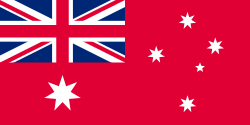 |
1909–present | Australian Red Ensign[1] | Flag modified with the addition of two points to the Commonwealth Star |
 |
1935–1948 | Australian Civil Air Ensign[40] | Based on the British Civil Air Ensign, with the addition of the Southern Cross and Commonwealth Star in yellow. |
 |
1948–present | Australian Civil Air Ensign[40] | Stars altered to white to improve visibility |
Australian Defence Force
| Flag | Date | Use | Description |
|---|---|---|---|
| 2000–present | Australian Defence Force Ensign[40] | A tricolour of dark blue (navy); red (army) and light blue (airforce) with the triservice badge. | |
| 2000–present | Personal flag of the Chief of the Defence Force[41] | A horizontal tricolour of dark blue (navy); red (army) and light blue (airforce) with the triservice badge and four gold stars. | |
| 2000–present | Personal flag of the Vice Chief of the Defence Force[citation needed] | A tricolour of dark blue (navy); red (army) and light blue (airforce) with the triservice badge and three gold stars. |
Royal Australian Navy
| Flag | Date | Use | Description |
|---|---|---|---|
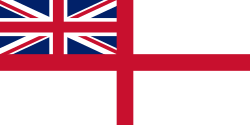 |
circa 1910–1967 | Royal Australian Navy Ensign[42] | British White Ensign |
 |
1967–present | Australian White Ensign[40] | A version of the national flag with a white field defaced with a blue Commonwealth Star in the lower canton quarter and a blue Southern Cross in the fly. |
 |
1920–1976, 1981– present | Personal flag of the Chief of Navy[43] | A fouled anchor on a red-blue background. Derived from the flag of the British Admiralty. |
 |
1983–Present | King's Colour for the Royal Australian Navy[44] |
Royal Australian Air Force
| Flag | Date | Use | Description |
|---|---|---|---|
 |
1921–1948 | Royal Australian Air Force Ensign[40] | British Royal Air Force Ensign |
 |
1948–1982 | Royal Australian Air Force Ensign[40][45] | The national flag with a light blue field, the Southern Cross tilted and the RAAF roundel placed in the lower fly. |
 |
1982–present | Royal Australian Air Force Ensign[40][46] | The national flag with a light blue field, the Southern Cross tilted and the RAAF roundel (Kangaroo) placed in the lower fly. |
Australian Border Force
| Flag | Date | Use | Description |
|---|---|---|---|
 |
2015–present | Australian Border Force Flag[40] | The Australian national flag defaced with "AUSTRALIAN BORDER FORCE" |
Federal and state police
| Flag | Date | Use | Description |
|---|---|---|---|
 |
1982–present | Flag of the Australian Federal Police[40] | A black-white-black vertical tricolor, with the badge of the Australian Federal Police in the centre of the white stripe. A black-and-white checkerboard borders the flag. |
 |
2006–present | Flag of the Queensland Police Service[47] | A light blue-and-dark blue horizontal bicolor with the badge of the Queensland Police Service in the centre of the flag. |
 |
2005–present | Flag of the Western Australia Police[48] | A white flag with a stylised depiction of a swan and chequerboard in blue, with the Western Australia Police emblem added. Replaced previous flag in use from 1970–2000. |
Sporting flags
| Flag | Date | Use | Description |
|---|---|---|---|
 |
1983–present | Boxing Kangaroo sporting flag[49] | A golden kangaroo wearing red boxing gloves on a green field. A registered trademark of the Australian Olympic Committee.[49] |
Ethnic groups flags
| Flag | Date | Use | Description |
|---|---|---|---|
| 2021–present | Flag of Taungurung[50] | A rectangle diagonally divided by a yellow wavy line. (Heraldic) The right side is ocher with the 7 stars arranged into the constellation of the Pleiades, the left side is black. | |
 |
1998–present | Flag of South Sea Islanders[51][52] | Designed in 1994 and formally adopted by the Australian South Sea Islanders United Council in 1998.[53] |
Other historical flags
| Flag | Date | Use | Description |
|---|---|---|---|
 |
1788–1801 | Union Flag | The Union Flag of the Kingdom of Great Britain. Raised by Captain Arthur Phillip RN on 26 January 1788 at Sydney Cove upon the landing of the First Fleet. |
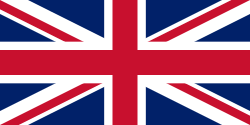 |
1801– present | Union Flag | The Union Flag of the United Kingdom and the British Empire. Given priority over what is now known as the Australian National Flag until the passage of the Flags Act 1953. |
 |
1806 | Bowman flag[54] | A white swallow-tail fly, with a crest featuring the Rose of England, the thistle of Scotland and the shamrock of Northern Ireland supported by an emu and kangaroo. The design was an inspiration for Australia's national coat of arms. |
 |
1823/24–1831 | National Colonial Flag for Australia[55] | A British White Ensign, featuring four white stars on the red cross |
  |
1831–1903 (de facto Flag of Australia); 1903–1920s (still commonly used) | Australian Federation Flag/New South Wales Ensign[55] | A British White Ensign, featuring the Cross in Azure with five Argent Stars often varying between 5–8 Points. It was the de facto flag of Australia from 1 January 1901 to 3 September 1901. It was widely used in New South Wales as a local shipping ensign until 1883 when the Admiralty banned its continued use at sea. The Australian government received approval to fly the Blue Ensign in 1903—but the Australian Federation Flag was still commonly unofficially used by members of the populace as late as the 1920s. |
 |
1849–1853 | Australian Anti-Transportation League Flag[55] | British Blue Ensign, with yellow Southern Cross and white border, to which branch names were added |
  |
1854 | Eureka Flag[55] | The battle flag of the Eureka Stockade featured the five stars of the constellation Crux Australis in white on a white cross and blue field |
| 1901–1904 | Louis Bernacchi's sledge flag | Sledge flag used in Antarctica by Louis Bernacchi, an Australian member of Robert Falcon Scott's Discovery Expedition (1901–1904) | |
| 1910–1913 | Frank Debenham's sledge flag | Sledge flag used in Antarctica by Frank Debenham, an Australian member of Robert Falcon Scott's Terra Nova Expedition (1910–1913) | |
| 1910–1913 | Thomas Griffith Taylor's sledge flag | Sledge flag used in Antarctica by Thomas Griffith Taylor, an Anglo-Australian member of the Terra Nova Expedition | |
 |
Post 1910–c. 1945 | British Empire flag | An unofficial flag of the British Empire featuring its constituent dominions and India. The Australian coat of arms are featured in the bottom right. It was flown by civilians as a display of patriotism on special occasions such as Empire Day. The flag was flown at the official unveiling of the Dangarsleigh War Memorial in 1921, and again at the centennial in 2021.[56] |
 |
1950s–1966 | Car flag of the prime minister of Australia | The Australian national flag defaced with the coat of arms of Australia placed between the Commonwealth Star and the Southern Cross. Used by Robert Menzies in the 1950s and 1960s.[57][58] |
See also
Notes
- The rendition of the crown has changed according to the monarchs' wishes. In c. 1901 it was changed to the Tudor Crown, and in 1963 to the St Edward's Crown.
References
Wikiwand - on
Seamless Wikipedia browsing. On steroids.


